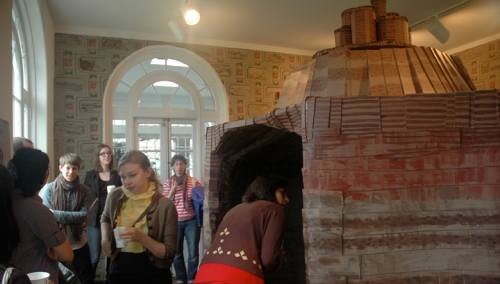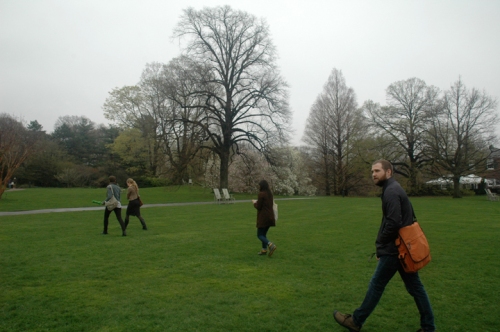Studio Visit – Meghan Gordon
Date: Saturday, April 23rd, 2011
Location: Bronx, NY
Wave Hill – Sunroom Project Space
Wave Hill Press Release for Gordon’s installation “Frederick Samuel Dellenbaugh would have liked to explore the Palisades”
Meghan Gordon investigates the merits of the cultural institution as an authoritative source for retelling the past. Gordon’s newest project, created during her Winter Workspace Residency, merges marginal fragments of Wave Hill history and reconfigures them through the lens of narrative projection. The crux of Gordon’s Sunroom Project is the artist and explorer Frederick Samuel Dellenbaugh (1853-1935), who, at age 17, joined Major John Wesley Powell’s second expedition through the last uncharted segment of the Colorado River. As the expedition’s artist, Dellenbaugh made a continuous drawing of the river’s left bank and helped prepare the first map of the Grand Canyon. Gordon first learned of the artist/explorer while researching the mural in Wave Hill’s Ecology Building, which has been attributed to Dellenbaugh.*
While naming unknown landforms to be mapped, Dellenbaugh proclaimed that one butte resembled an art gallery, an anecdote that inspired Gordon to create a butte art gallery within the gallery. The interior of this structure recalls the defunct, underground tunnel connecting Wave Hill’s Glyndor House to the Ecology Building. Gordon has installed paper tiles that mimic the Guastavino tiles that once lined the tunnel, suggesting the physical connection between the gallery and the mural, the notion of lost or missing history and the institutional desire to fill in the gaps. The structure also houses a video that partially retells Dellenbaugh’s adventure in which Gordon assumes the role of Edith, a misguided tour guide who uses the Hudson River as an inadequate substitute for the Colorado. On the walls of the Sunroom is Gordon’s recreation of period wallpaper, c. 1865. The painted vignettes are free-hand interpretations of Dellenbaugh’s drawings, which contrast the rigidity of the wallpaper’s pattern highlighting the containment of the wilderness and acknowledges the creation of a mediated view of nature.
Born in New York City, Gordon is a graduate of Rhode Island School of Design. She has been awarded numerous residencies, including Art342 in Fort Collins, CO; the MacDowell Colony in Peterborough, NH; the Seven Below Arts Initiative in Burlington, VT; the Kimmel Harding Nelson Center in Nebraska City, NE; and has twice been a Fellow at the Fine Arts Work Center in Provincetown, MA. Gordon is currently a Dieu Donné Workspace Program Artist, a Lower Manhattan Cultural Council Workspace Resident and a New York Foundation for the Arts Fellow. Gordon thanks Richard Maurer for invaluable contributions, as well as the Lower Manhattan Cultural Council, Materials for the Arts and the New York Foundation for the Arts for their support.
*The unsigned mural was attributed to Dellenbaugh by William Stiles (1912–80), former curator of the Museum of the American Indian, who analyzed the mural and identified its scenes of Native American life. However, descendants of George W. Perkins, who commissioned the mural in 1909, believe that it was painted by Howard McCormick (1875–1943).
Organized by Assistant Curator Gabriel de Guzman, the Sunroom Project Space provides an opportunity for New York’s emerging artists to develop a special project or create a new body of work to exhibit in a solo show.
http://wavehill.org/arts/meghan_gordon_sunroom.html
http://meghangordonstudio.com/
Exhibition Discussion Synopsis:
The background information for Meghan Gordon’s project at Wave Hill is best stated above.
In her work, Meghan Gordon investigates history, trust, interpretation and presentation. She is drawn to the awkwardness of incorrect theses and failures in history.
The piece at Wave Hill fills their sunroom space. Covering the walls of the room, Meghan has fashioned hand-painted wallpaper featuring renditions of Frederick Samuel Dellenbaugh’s sketches of the Colorado River banks. She has also built a painted structure out of paper, paper pulp and cardboard in the center of the room which visually references one of the buttes recorded in Dellenbaugh’s log; he referred to it as an “art gallery”. Inside the “art gallery” the viewer finds Guastavino tiles made of paper overhead referring to the structural tiles that line a now defunct underground tunnel that leads to the Wave Hill building housing a mural that was attributed* to Dellenbaugh. Also in the butte is a video that documents “Edith” an ardent yet somewhat inept docent and bewigged alter ego of artist Meghan Gordon. Edith incongruently presents the Hudson River as a proxy for the Colorado in this video tour of the Powel expedition. This video serves as a simultaneous mouthpiece and veil for Dellenbaugh’s experience as presented though quotes from text on the Powell exhibition. Edith’s monologue provides a narrative grounding of background information, through artifice of situation and production quality, while effectively obscuring the information and adding moments of deadpan humor.
Meghan discussed her material choice of paper and cardboard as a lesson in impermanence. As her background is in painting, Meghan often approaches her work with a 2D mindset to make 3D pieces. Her investigation of historical subject matter and objects began with a series of paintings of the contents of museum period rooms and other personally notable interiors. This work led her to other researched projects where she replicated paper objects lost to history and created a period room with a borrowed narrative.
Her current project is more of an interpretation of research than a re-assembly of the documented. The group discussed the role of the historian and the role of the artist. By trying on both roles in this project Meghan has employed the different liberties allotted to the historian and artist respectively. So far in her projects she has been hesitant to use text or provide “the official say” on an event, time or object. She prefers the role of the interpreter or re-interpreter of history rather than the purveyor. Meghan is interested in the different ways in which the public engages the historical framework and the art space. On many levels her work is made as an institutional critique of the authority of information as a given. Her approach is meant to be at once critical of herself as an artist, Dellenbaugh as a recorder, historians, critics and the audience, citing that viewers are responsible for considering information presented to them. In this project however, Meghan does not force factual awareness by misleading the audience, but instead molds the way images and anecdotes are rendered and viewed. The group compared the differences between the performative aspects of this project to the making of objects and environments and the way that the viewer interacts with each aspect.
-Amanda Lechner
Discussion Links:
Coco Fusco and Guillermo Gomez-Peña. Undiscovered Amerindians
Mark Dion : Travels of William Bartram Reconsidered








0 Responses to “Meghan Gordon – Studio Visit – April 23rd, 2011”